Assessment of Land Desertification and Its Drivers on the Mongolian Plateau Using Intensity Analysis and the Geographical Detector Technique
Abstract
1. Introduction
2. Materials and Methods
2.1. Study Area
2.2. Data and Processing
2.3. Desertification Classification, Interpretation and Verification
2.4. Methods
2.4.1. Intensity Analysis Method
2.4.2. Geographical Detector Method
3. Results
3.1. Spatiotemporal Evolution of Desertified Land Area
3.2. Transfer Characteristics of Desertification
3.2.1. Interval Level
3.2.2. Category Level
3.2.3. Transition Level
3.3. Drivers of Land Desertification
4. Discussion
4.1. Desertification Dynamics
4.2. Desertification Drivers
4.3. Limitations with Possible Future Work
5. Conclusions
- (1)
- During the monitoring period, the desertification of the East Ujimqin Banner experienced a process of reversion-development-mild development, with slight desertified lands dominating in 2000, 2010, and 2015, and very serious desertified lands dominating in 2005. Desertification in the three counties of Mongolia underwent the process of development, mild development, and mild development. In 2000 and 2005, it was dominated by VS, whereas it was dominated by SL in 2010 and 2015.
- (2)
- In space, vs. was mainly concentrated around the waters of the East Ujimqin Banner and the southern part of Chalchyn Gol County, and the former was mainly salinized, while the latter was characterized by aeolian desertification. The central and southwestern parts of the East Ujimqin Banner and the northern edge of Matad County were dominated by SL.
- (3)
- The two time intervals between 2000–2005 and 2005–2010 formed the period of rapid change in desertification in the study area, with the most significant changes occurring in the 2000–2005 period. From 2000 to 2005, the East Ujimqin Banner was mainly characterized by the reversion of SL into N (non desertified land) and the development of WA (water areas) to VS. The dynamic characteristics of desertification in the three counties of Mongolia were developed from N to SL, S, and vs. reversed to S to M, respectively, during the 2000–2005 period.
- (4)
- Wind speed had the strongest explanatory power for desertification dynamics in the study area. The explanatory power of the number of livestock on the desertification dynamics in the East Ujimqin Banner was larger than that in the three counties in Mongolia. In addition, the interaction between natural and anthropogenic factors was shown to enhance the explanatory power of the desertification dynamics in the study area.
Supplementary Materials
Author Contributions
Funding
Data Availability Statement
Conflicts of Interest
References
- Negash, S.G. Spatial Assessment of NDVI as an Indicator of Desertification in Ethiopia Using Remote Sensing and GIS. Master’s Thesis, Lund University, Lund, Sweden, 2016. [Google Scholar]
- Briassoulis, H. Combating land degradation and desertification: The land-use planning quandary. Land 2019, 8, 27. [Google Scholar] [CrossRef]
- Behnke, R.H. The Socio-Economic Causes and Consequences of Desertification in Central Asia, 1st ed.; Springer: Dordrecht, The Nethlands, 2008. [Google Scholar]
- Peters, D.P.; Havstad, K.M.; Archer, S.R.; Sala, O.E. Beyond desertification: New paradigms for dryland landscapes. Front. Ecol. Environ. 2015, 13, 4–12. [Google Scholar] [CrossRef] [PubMed]
- Ci, L.; Yang, X. Desertification and Its Control in China; Higher Education Press: Beijing, China, 2010. [Google Scholar]
- Becerril-Piña, R.; Díaz-Delgado, C.; Mastachi-Loza, C.A.; González-Sosa, E. Integration of remote sensing techniques for monitoring desertification in Mexico. Hum. Ecol. Risk Assess. 2016, 22, 1323–1340. [Google Scholar] [CrossRef]
- Zhao, X.; Hu, H.; Shen, H.; Zhou, D.; Zhou, L.; Myneni, R.B.; Fang, J. Satellite-indicated long-term vegetation changes and their drivers on the Mongolian Plateau. Landsc. Ecol. 2015, 30, 1599–1611. [Google Scholar] [CrossRef]
- Miao, L.; Müller, D.; Cui, X.; Ma, M. Changes in vegetation phenology on the Mongolian Plateau and their climatic determinants. PLoS ONE 2017, 12, e0190313. [Google Scholar] [CrossRef] [PubMed]
- Liang, M.; Smith, N.G.; Chen, J.; Wu, Y.; Guo, Z.; Gornish, E.S.; Liang, C. Shifts in plant composition mediate grazing effects on carbon cycling in grasslands. J. Appl. Ecol. 2021, 58, 518–527. [Google Scholar] [CrossRef]
- Angerer, J.; Han, G.; Fujisaki, I.; Havstad, K. Climate change and ecosystems of Asia with emphasis on Inner Mongolia and Mongolia. Rangelands 2008, 30, 46–51. [Google Scholar] [CrossRef]
- Liu, S.; Wang, T. Aeolian desertification from the mid-1970s to 2005 in Otindag Sandy Land, Northern China. Environ. Geol. 2007, 51, 1057–1064. [Google Scholar] [CrossRef]
- Tu, Z.F.; Li, M.X.; Sun, T. The status and trend analysis of desertification and sandification. For. Resour. Manag. 2016, 1, 1–5. (In Chinese) [Google Scholar]
- Buren, G. Research on Current Status, Causes and Prospect of Desertification in Mongolia. Master’s Thesis, Inner Mongolia University, Hohhot, China, 2011. (In Chinese). [Google Scholar]
- Singh, S. Desertification mapping in western Rajasthan. Ann. Arid Zone 1992, 31, 237–246. [Google Scholar]
- Hong, Y.Y. Analysis of Spatial-Temporal Changes of Vegetation NDVI in Border Areas of China-Mongolia. Master’s Thesis, Inner Mongolia Normal University, Hohhot, China, 2016. (In Chinese). [Google Scholar]
- Kundu, A.; Dutta, D. Monitoring desertification risk through climate change and anthropogenic interference using remote sensing and GIS techniques. Int. J. Geomat. Geosci. 2011, 2, 21–33. [Google Scholar]
- Han, L.; Zhang, Z.; Zhang, Q.; Wan, X. Desertification assessments in the Hexi corridor of northern China’s Gansu Province by remote sensing. Nat. Hazards 2015, 75, 2715–2731. [Google Scholar] [CrossRef]
- Lamchin, M.; Lee, J.Y.; Lee, W.K.; Lee, E.J.; Kim, M.; Lim, C.H.; Kim, S.R. Assessment of land cover change and desertification using remote sensing technology in a local region of Mongolia. Adv. Space Res. 2016, 57, 64–77. [Google Scholar] [CrossRef]
- Kundu, A.; Patel, N.R.; Saha, S.K.; Dutta, D. Desertification in western Rajasthan (India): An assessment using remote sensing derived rain-use efficiency and residual trend methods. Nat. Hazards 2017, 86, 297–313. [Google Scholar] [CrossRef]
- Zhang, F.; Tiyip, T.; Johnson, V.C.; Kung, H.; Ding, J.; Zhou, M.; Fan, Y.; Kelimu, A.; Nurmuhammat, I. Evaluation of land desertification from 1990 to 2010 and its causes in Ebinur Lake region, Xinjiang China. Environ. Earth Sci. 2015, 73, 5731–5745. [Google Scholar] [CrossRef]
- Duan, H.C.; Wang, T.; Xue, X.; Liu, S.L.; Guo, J. Dynamics of aeolian desertification and its driving forces in the Horqin Sandy Land, Northern China. Environ. Monit. Assess. 2014, 186, 6083–6096. [Google Scholar] [CrossRef]
- Song, X.; Wang, T.; Xue, X.; Yan, C.; Li, S. Monitoring and analysis of aeolian desertification dynamics from 1975 to 2010 in the Heihe River Basin, northwestern China. Environ. Earth Sci. 2015, 74, 3123–3133. [Google Scholar] [CrossRef]
- Becker, F.; Choudhury, B.J. Relative sensitivity of normalized difference vegetation index (NDVI) and microwave polarization difference index (MPDI) for vegetation and desertification monitoring. Remote Sens. Environ. 1988, 24, 297–311. [Google Scholar] [CrossRef]
- Sternberg, T.; Tsolmon, R.; Middleton, N.; Thomas, D. Tracking desertification on the Mongolian steppe through NDVI and field-survey data. Int. J. Digit. Earth 2011, 4, 50–64. [Google Scholar] [CrossRef]
- Pan, J.; Li, T. Extracting desertification from Landsat TM imagery based on spectral mixture analysis and Albedo-Vegetation feature space. Nat. Hazards 2013, 68, 915–927. [Google Scholar] [CrossRef]
- Wang, Y.F.; Zhang, J.Q.; Tong, S.Q.; Guo, E.L. Monitoring the trends of aeolian desertified lands based on time-series remote sensing data in the Horqin Sandy Land, China. Catena 2017, 157, 286–298. [Google Scholar] [CrossRef]
- United Nations Convention to Combat Desertification (UNCCD). United Nations Convention to Combat Desertification in Countries Experiencing Serious Drought and/or Desertification, Particularly in Africa; United Nations: Paris, France, 1994. [Google Scholar]
- Xu, D.; Li, C.; Song, X.; Ren, H. The dynamics of desertification in the farming-pastoral region of North China over the past 10 years and their relationship to climate change and anthropogenic activity. Catena 2014, 123, 11–22. [Google Scholar] [CrossRef]
- Feng, L.; Jia, Z.; Li, Q. The dynamic monitoring of aeolian desertification land distribution and its response to climate change in northern China. Sci. Rep. 2016, 6, 39563. [Google Scholar] [CrossRef][Green Version]
- Wang, X.; Cheng, H.; Li, H.; Lou, J.; Hua, T.; Liu, W.; Zhu, B. Key driving forces of desertification in the Mu Us Desert, China. Sci. Rep. 2017, 7, 3933. [Google Scholar] [CrossRef]
- Li, Q.; Zhang, C.; Shen, Y.; Jia, W.; Li, J. Developing trend of aeolian desertification in China’s Tibet Autonomous Region from 1977 to 2010. Environ. Earth Sci. 2016, 75, 895. [Google Scholar] [CrossRef]
- Xue, Z.; Qin, Z.; Cheng, F.; Ding, G.; Li, H. Quantitative assessment of aeolian desertification dynamics–A case study in north Shanxi of China (1975 to 2015). Sci. Rep. 2017, 7, 10460. [Google Scholar] [CrossRef]
- Zhang, G.; Biradar, C.M.; Xiao, X.; Dong, J.; Zhou, Y.; Qin, Y. Exacerbated grassland degradation and desertification in Central Asia during 2000–2014. Ecol. Appl. 2018, 28, 442–456. [Google Scholar] [CrossRef]
- Wang, J.F.; Li, X.H.; Christakos, G.; Liao, Y.L.; Zhang, T.; Gu, X.; Zheng, X.Y. Geographical detectors-based health risk assessment and its application in the neural tube defects study of the Heshun Region, China. Int. J. Geogr. Inf. Sci. 2010, 24, 107–127. [Google Scholar] [CrossRef]
- Wang, J.F.; Hu, Y. Environmental health risk detection with GeogDetector. Environ. Model. Softw. 2012, 33, 114–115. [Google Scholar] [CrossRef]
- Zheng, K.; Tan, L.; Sun, Y.; Wu, Y.; Duan, Z.; Xu, Y.; Gao, C. Impacts of climate change and anthropogenic activities on vegetation change: Evidence from typical areas in China. Ecol. Indic. 2021, 126, 107648. [Google Scholar] [CrossRef]
- Dong, Y.; Yin, D.; Li, X.; Huang, J.; Su, W.; Li, X.; Wang, H. Spatial–temporal evolution of vegetation NDVI in association with climatic, environmental and anthropogenic factors in the loess plateau, China during 2000–2015: Quantitative analysis based on geographical detector model. Remote Sens. 2021, 13, 4380. [Google Scholar] [CrossRef]
- Zhang, J.; Yang, G.; Yang, L.; Li, Z.; Gao, M.; Yu, C.; Gong, E.; Long, H.; Hu, H. Dynamic Monitoring of Environmental Quality in the Loess Plateau from 2000 to 2020 Using the Google Earth Engine Platform and the Remote Sensing Ecological Index. Remote Sens. 2022, 14, 5094. [Google Scholar] [CrossRef]
- Venkatesh, K.; John, R.; Chen, J.; Xiao, J.; Amirkhiz, R.G.; Giannico, V.; Kussainova, M. Optimal ranges of social-environmental drivers and their impacts on vegetation dynamics in Kazakhstan. Sci. Total Environ. 2022, 847, 157562. [Google Scholar] [CrossRef]
- Guo, B.; Wei, C.; Yu, Y.; Liu, Y.; Li, J.; Meng, C.; Cai, Y. The dominant influencing factors of desertification changes in the source region of Yellow River: Climate change or anthropogenic activity? Sci. Total Environ. 2022, 813, 152512. [Google Scholar] [CrossRef]
- Tomasella, J.; Vieira, R.M.S.P.; Barbosa, A.A.; Rodriguez, D.A.; de Oliveira, S.M.; Sestini, M.F. Desertification trends in the Northeast of Brazil over the period 2000–2016. Int. J. Appl. Earth Obs. 2018, 73, 197–206. [Google Scholar] [CrossRef]
- Huang, J.; Pontius, R.G., Jr.; Li, Q.; Zhang, Y. Use of intensity analysis to link patterns with processes of land change from 1986 to 2007 in a coastal watershed of southeast China. Appl. Geogr. 2012, 34, 371–384. [Google Scholar] [CrossRef]
- Pontius, R.G.; Shusas, E.; McEachern, M. Detecting important categorical land change while accounting for persistence. Agric. Ecosyst. Environ. 2004, 101, 251–268. [Google Scholar] [CrossRef]
- Wei, H.; Wang, J.; Cheng, K.; Li, G.; Ochir, A.; Davaasuren, D.; Chonokhuu, S. Desertification information extraction based on feature space combinations on the Mongolian plateau. Remote Sens. 2018, 10, 1614. [Google Scholar] [CrossRef]
- Zhang, X.; Zhang, S. China-Mongolia-Russia economic corridor and environmental protection cooperation. R-Economy 2017, 3, 161–166. [Google Scholar] [CrossRef][Green Version]
- Sa, R. Analysis of Desertification Changes in China-Mongolia Border Area Based on Landsat TM Data. Master’s Thesis, Inner Mongolia Normal University, Hohhot, China, 2017. (In Chinese). [Google Scholar]
- Meng, X.Z. A Study on the Influences of Mongolia Desertification on the Desertification in Northern China. Master’s Thesis, Jilin University, Changchun, China, 2012. (In Chinese). [Google Scholar]
- Peel, M.C.; Finlayson, B.L.; McMahon, T.A. Updated world map of the Köppen-Geiger climate classification. Hydrol. Earth Syst. Sci. 2007, 11, 1633–1644. [Google Scholar] [CrossRef]
- Guo, Q.; Fu, B.; Shi, P.; Cudahy, T.; Zhang, J.; Xu, H. Satellite monitoring the spatial-temporal dynamics of desertification in response to climate change and anthropogenic activities across the ordos plateau, China. Remote Sens. 2017, 9, 525. [Google Scholar] [CrossRef]
- Abatzoglou, J.T.; Dobrowski, S.Z.; Parks, S.A.; Hegewisch, K.C. TerraClimate, a high-resolution global dataset of monthly climate and climatic water balance from 1958–2015. Sci. Data 2018, 5, 170191. [Google Scholar] [CrossRef]
- Gilbert, M.; Nicolas, G.; Cinardi, G.; Van Boeckel, T.P.; Vanwambeke, S.O.; Wint, G.R.W.; Robinson, T.P. Global distribution data for cattle, buffaloes, horses, sheep, goats, pigs, chickens and ducks in 2010. Sci. Data 2018, 5, 180227. [Google Scholar] [CrossRef]
- Yin, S. Dynamic Study of Desertification in Hunshandake Sandy Land of Inner Mongolia. Ph.D. Thesis, Inner Mongolia Agricultural University, Hohhot, China, 2010. (In Chinese). [Google Scholar]
- Hu, Q.; Wu, W.; Xia, T.; Yu, Q.; Yang, P.; Li, Z.; Song, Q. Exploring the use of Google Earth imagery and object-based methods in land use/cover mapping. Remote Sens. 2003, 5, 6026–6042. [Google Scholar] [CrossRef]
- Wang, J.F.; Xu, C.D. Geodetector: Principle and prospective. Acta Geol. Sin. 2017, 72, 116–134. (In Chinese) [Google Scholar]
- Portnov, B.A.; Safriel, U.N. Combating desertification in the Negev: Dryland agriculture vs. dryland urbanization. J. Arid Environ. 2004, 56, 659–680. [Google Scholar] [CrossRef]
- Sivakumar, M.V.K. Interactions between climate and desertification. Agric. For. Meteorol. 2017, 142, 143–155. [Google Scholar] [CrossRef]
- Tao, W. Aeolian desertification and its control in Northern China. Int. Soil Water Conserv. Res. 2014, 2, 34–41. [Google Scholar] [CrossRef]
- Li, Y.W.; Li, C.L.; Liu, J.; Yin, S.; Bao, Y.H.; Bao, H.J.; Latengtuya, A. The dynamic change characteristics of land desertification in recent 20 years taking Xilingol League as case study. Soil Fertil. Sci. China 2015, 5, 1–6. (In Chinese) [Google Scholar]
- Wang, X.; Li, X.; Cai, D.; Lou, J.; Li, D.; Liu, F. Salinification and salt transports under aeolian processes in potential desertification regions of China. Sci. Total Environ. 2021, 782, 146832. [Google Scholar] [CrossRef]
- Feng, K.; Wang, T.; Liu, S.; Yan, C.; Kang, W.; Chen, X.; Guo, Z. Path analysis model to identify and analyse the causes of aeolian desertification in Mu Us Sandy Land, China. Ecol. Indic. 2021, 124, 107386. [Google Scholar] [CrossRef]
- Yin, Y.; Wu, S.; Chen, G.; Dai, E. Attribution analyses of potential evapotranspiration changes in China since the 1960s. Theor. Appl. Climatol. 2010, 101, 19–28. [Google Scholar] [CrossRef]
- Guo, X.; Chen, R.; Thomas, D.S.; Li, Q.; Xia, Z.; Pan, Z. Divergent processes and trends of desertification in Inner Mongolia and Mongolia. Land Degrad. Dev. 2021, 32, 3684–3697. [Google Scholar] [CrossRef]
- Venkatesh, K.; John, R.; Chen, J.; Jarchow, M.; Amirkhiz, R.G.; Giannico, V.; Saraf, S.; Jain, K.; Kussainova, M.; Yuan, J. Untangling the impacts of socioeconomic and climatic changes on vegetation greenness and productivity in Kazakhstan. Environ. Res. Lett. 2022, 17, 095007. [Google Scholar] [CrossRef]
- D’Odorico, P.; Bhattachan, A.; Davis, K.F.; Ravi, S.; Runyan, C.W. Global desertification: Drivers and feedbacks. Adv. Water Resour. 2013, 51, 326–344. [Google Scholar] [CrossRef]
- Xu, L.; Chen, N.; Yang, C.; Zhang, C.; Yu, H. A parametric multivariate drought index for drought monitoring and assessment under climate change. Agric. For. Meteorol. 2021, 310, 108657. [Google Scholar] [CrossRef]
- Afshar, M.H.; Bulut, B.; Duzenli, E.; Amjad, M.; Yilmaz, M.T. Global spatiotemporal consistency between meteorological and soil moisture drought indices. Agric. For. Meteorol. 2022, 316, 108848. [Google Scholar] [CrossRef]
- Li, Z.H.; Bao, Y.J.; Wang, H.M.; Xu, T.; Cheng, Y.; Gao, J.X. The analysis on degeneration status and the driving force of Xilinguole Steppe. Ecol. Environ. 2008, 17, 2312–2318. (In Chinese) [Google Scholar]
- Zhuo, L.; Cao, X.; Chen, J.; Chen, Z.X.; Shi, P.J. Assessment of grassland ecological restoration project in Xilingol Grassland. Acta Geol. Sin. 2007, 62, 471–480. (In Chinese) [Google Scholar]
- Wu, Z.R.; Jia, L.; Du, B.Z.; Hu, Y.F.; Yan, H.M.; Cao, X.C.; Long, X. Impact of ecological conservation program on lifestyle changes of households in Inner Mongolia. Resour. Sci. 2012, 34, 1049–1061. (In Chinese) [Google Scholar]
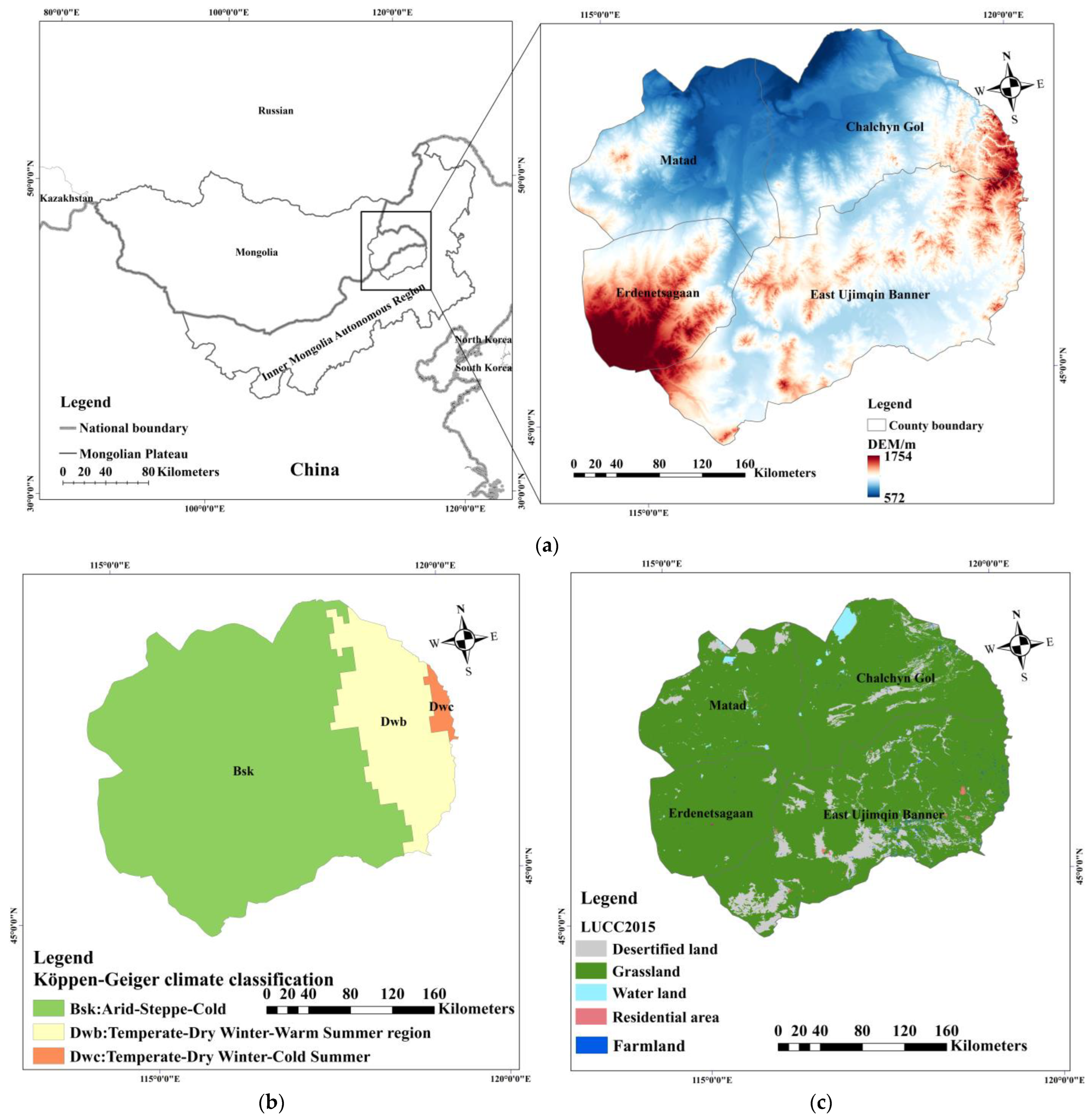
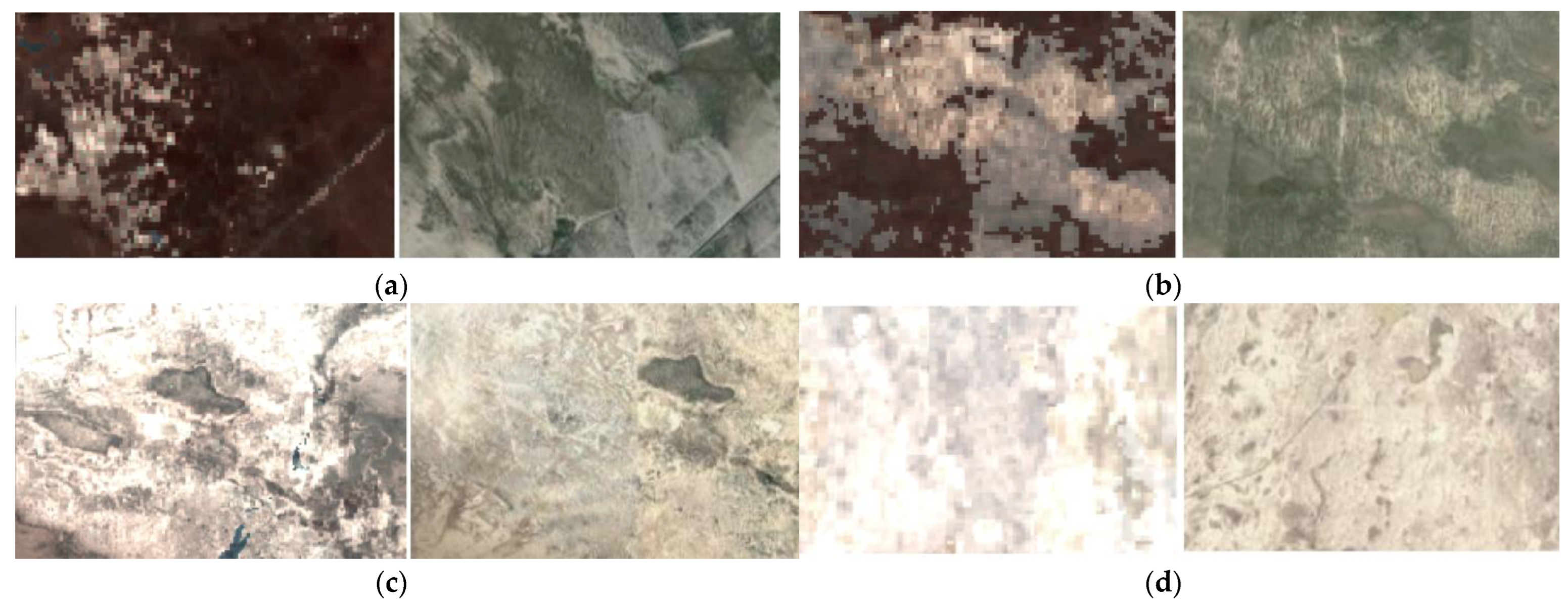


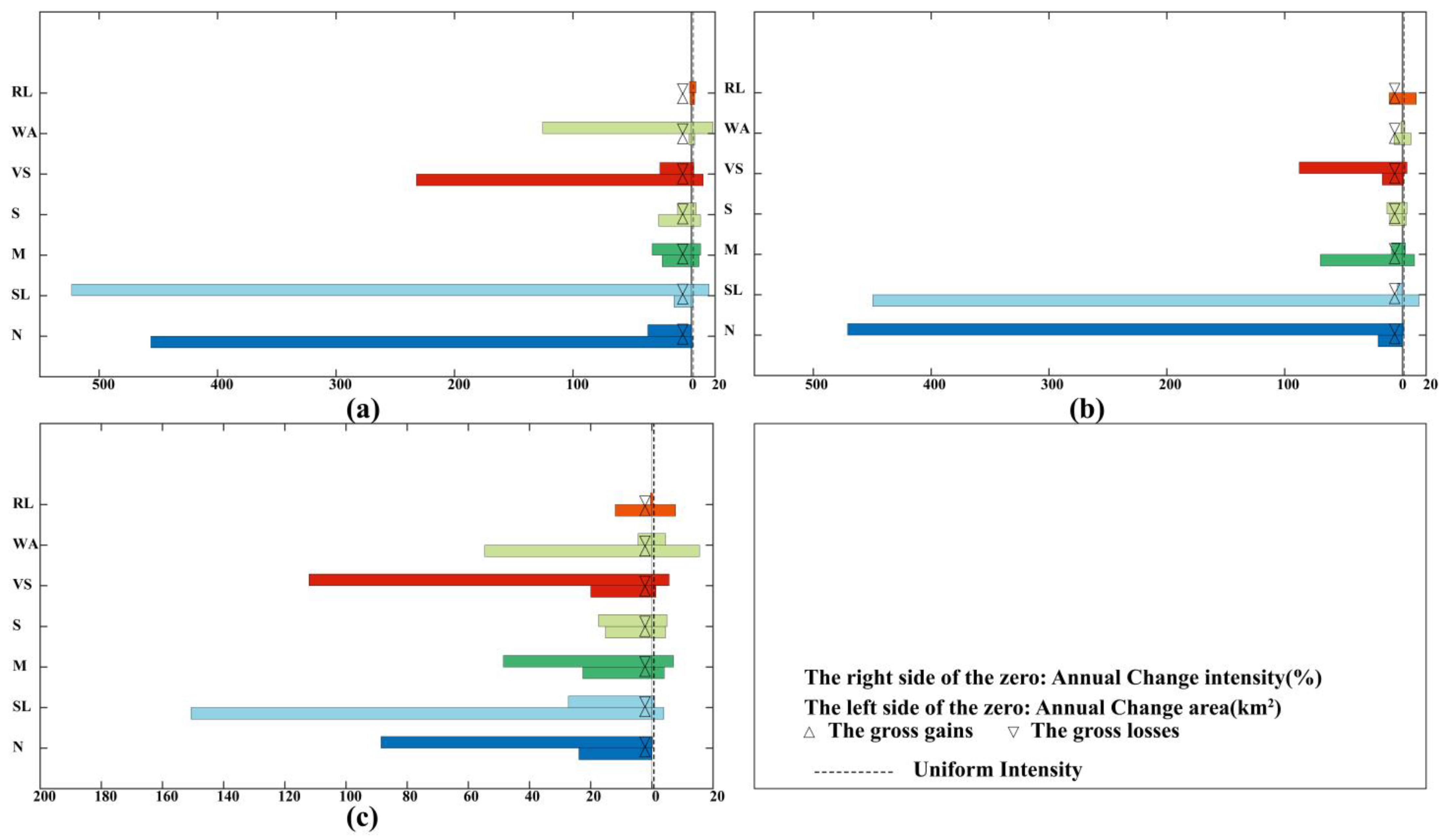

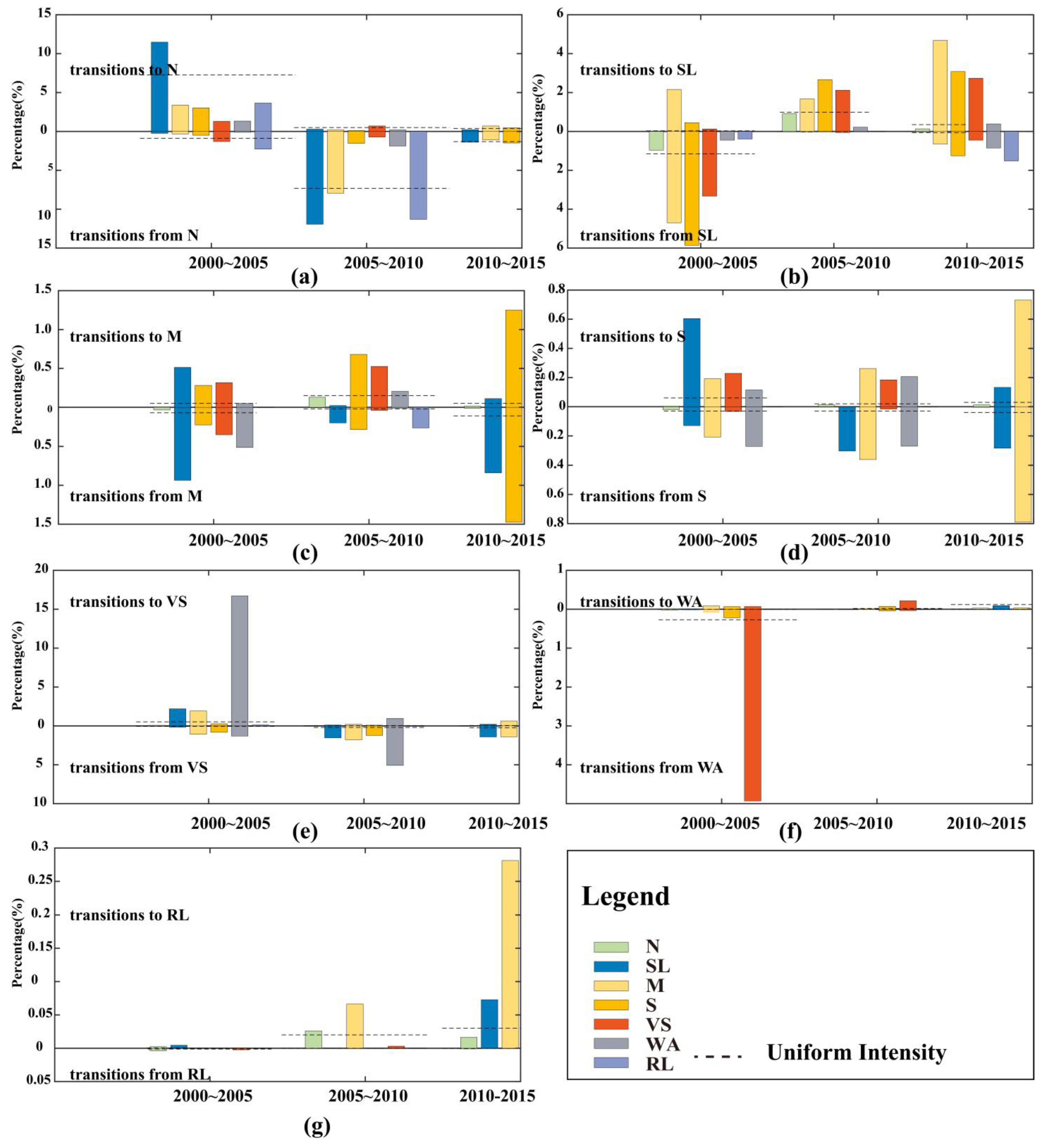
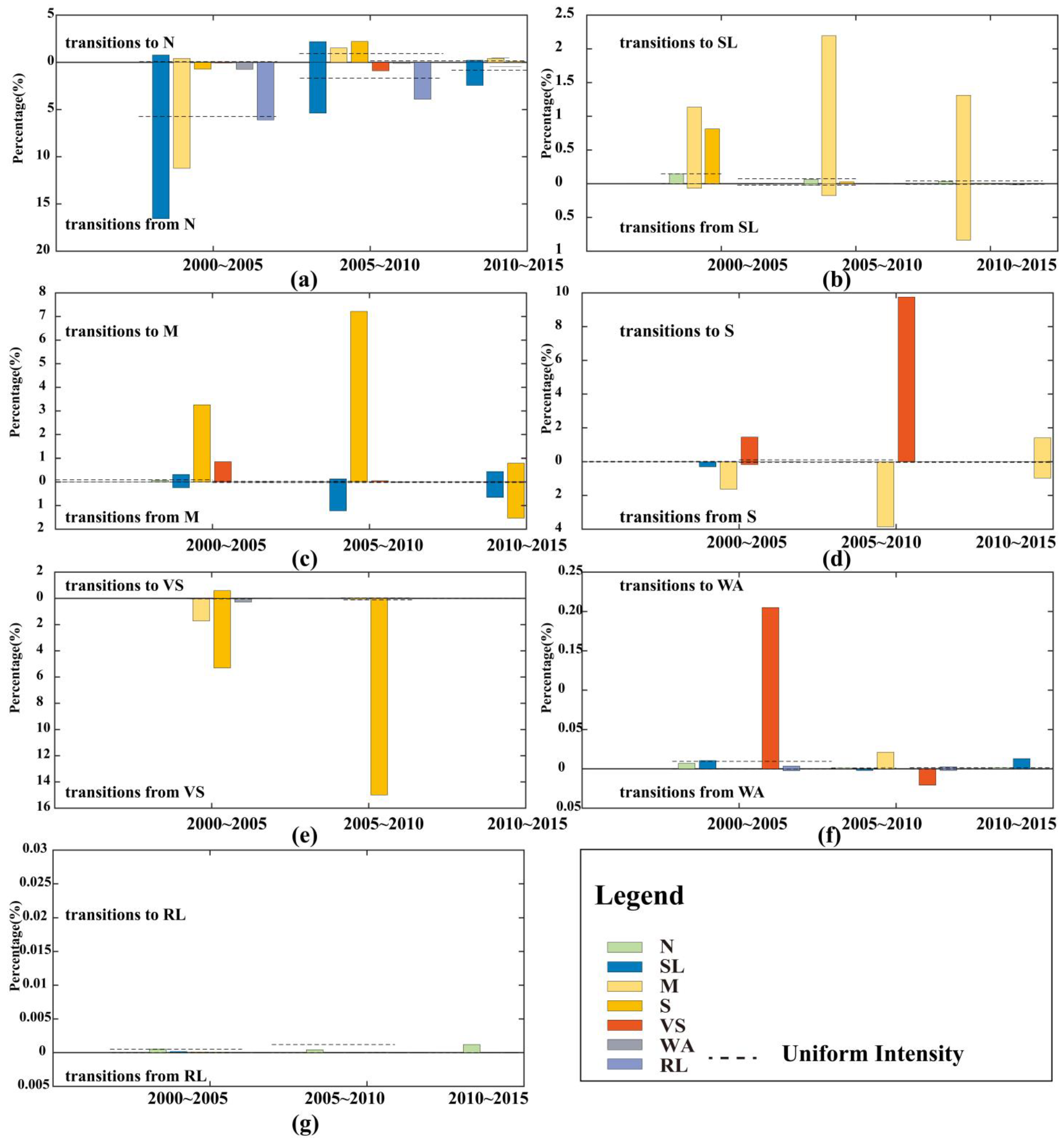
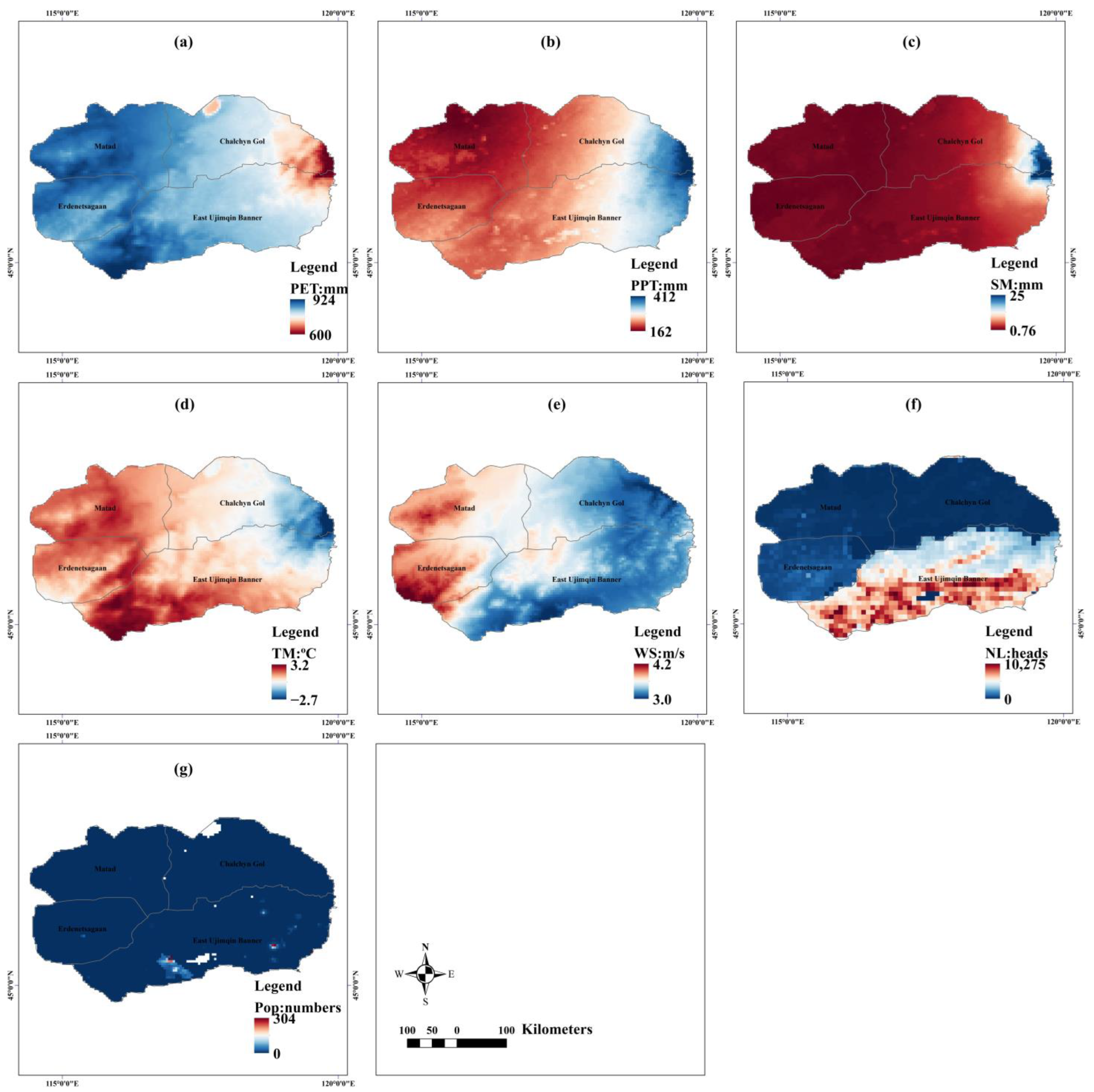
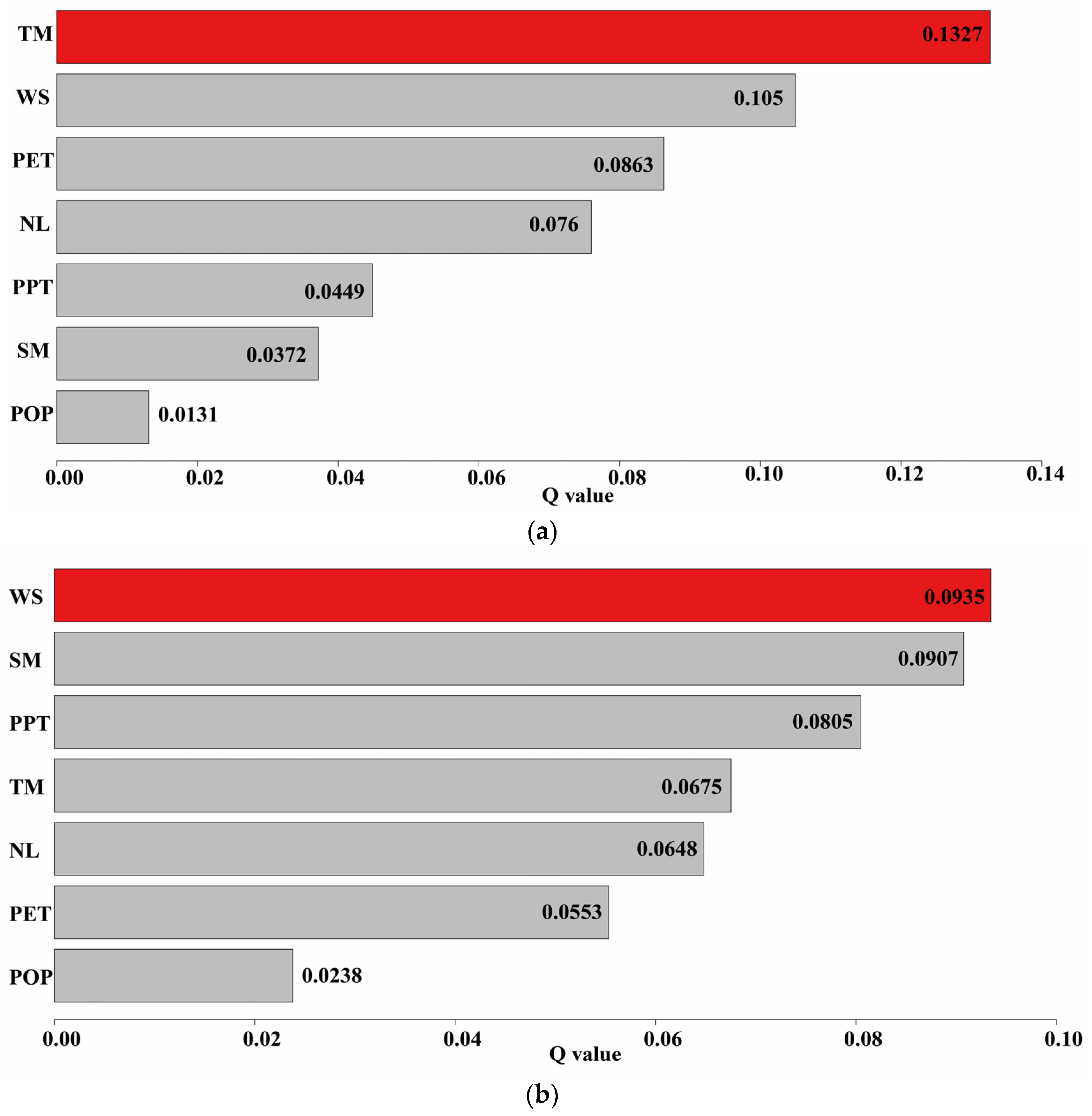
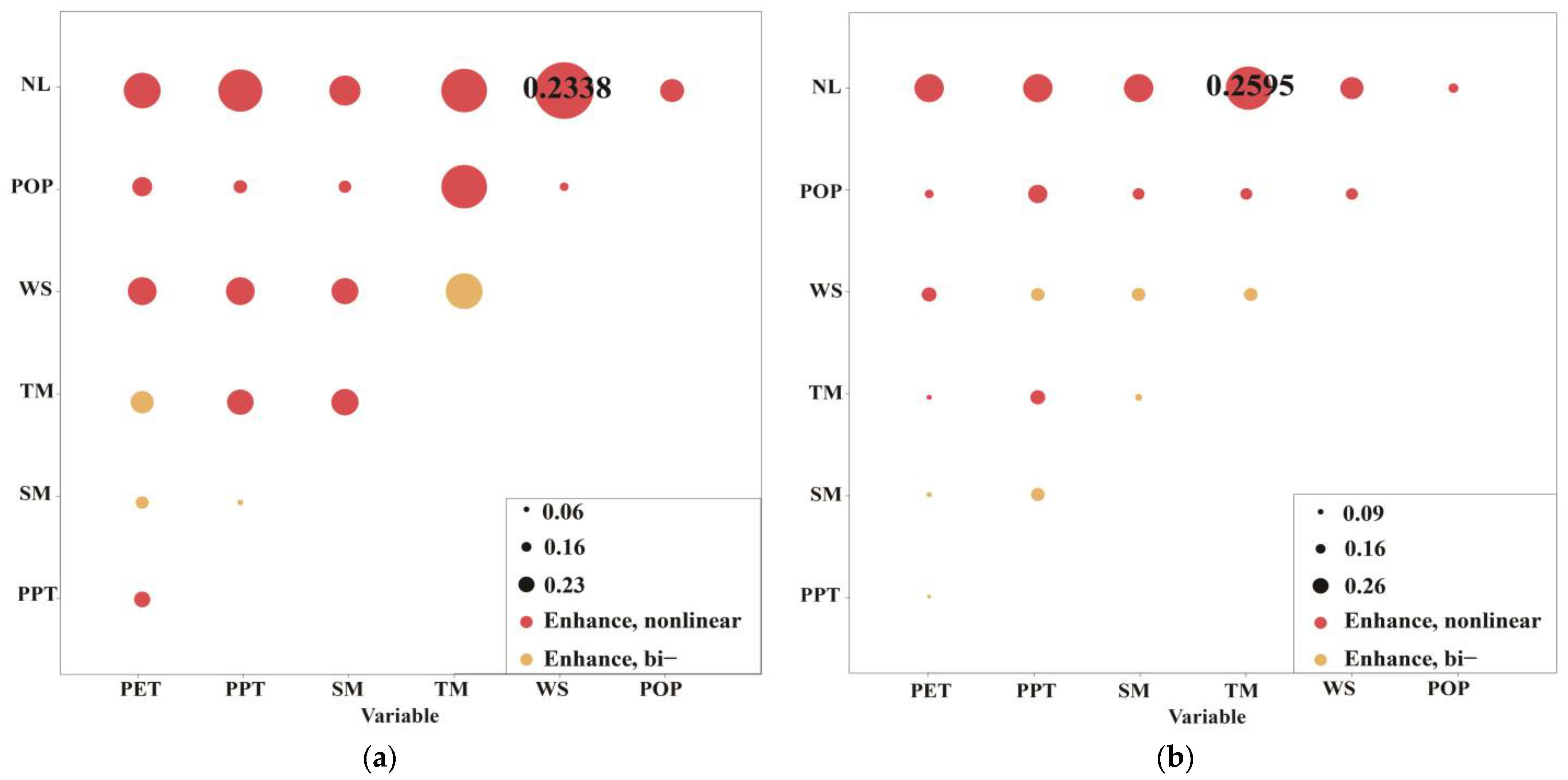
| Category | Vegetation Coverage | Image Features |
|---|---|---|
| Slight (SL) | 50–70% | The patches are red, and the sandy land is distributed in spots with vegetation. |
| Moderate (M) | 30–50% | Red and white are mixed in strips. |
| Serious (S) | 10–30% | Red mixed with white is distributed in flakes or spots, and severe wind erosion has occurred in most areas. |
| Very Serious (VS) | <10% | The overall appearance is bright white with only a small amount of speckled vegetation information |
| Description | Interaction |
|---|---|
| nonlinear weaken | |
| uni-weaken | |
| and | bi-enhance |
| nonlinearly enhance | |
| independent |
| Region | Year | SL | M | S | VS | Water Area | Residential Land |
|---|---|---|---|---|---|---|---|
| East Ujimqin Banner | 2000 | 3530.69 | 428.36 | 283.98 | 1307.04 | 688.35 | 43.17 |
| 3.105 | 0.377 | 0.25 | 1.15 | 0.605 | 0.038 | ||
| 2005 | 988.83 | 385.75 | 364.63 | 2334.52 | 70.06 | 40.39 | |
| 0.87 | 0.339 | 0.321 | 2.053 | 0.062 | 0.036 | ||
| 2010 | 3215.16 | 687.96 | 352.62 | 1982.03 | 100.02 | 96.71 | |
| 2.828 | 0.605 | 0.31 | 1.743 | 0.088 | 0.085 | ||
| 2015 | 3832.25 | 558.19 | 341.09 | 1521.49 | 350.70 | 154.27 | |
| 3.371 | 0.491 | 0.3 | 1.338 | 0.308 | 0.136 | ||
| 2000–2005 | −2541.86 | −42.61 | 80.65 | 1027.48 | −618.29 | −2.78 | |
| −2.236 | −0.037 | 0.071 | 0.904 | −0.544 | −0.002 | ||
| 2005–2010 | 2226.33 | 302.21 | −12.01 | −352.49 | 29.96 | 56.32 | |
| 1.958 | 0.266 | −0.011 | −0.31 | 0.026 | 0.05 | ||
| 2010–2015 | 617.09 | −129.77 | −11.53 | −460.54 | 250.68 | 57.56 | |
| 0.543 | −0.114 | −0.01 | −0.405 | 0.22 | 0.051 | ||
| 2000–2015 | 301.56 | 129.83 | 57.11 | 214.45 | −337.65 | 111.1 | |
| 0.266 | 0.114 | 0.05 | 0.188 | −0.297 | 0.098 | ||
| Three counties in Mongolia | 2000 | 124.75 | 173.78 | 298.09 | 1197.02 | 836.67 | 5.69 |
| 0.11 | 0.153 | 0.262 | 1.053 | 0.736 | 0.005 | ||
| 2005 | 811.99 | 597.2 | 327.09 | 1058.94 | 880.42 | 8.19 | |
| 0.714 | 0.525 | 0.288 | 0.931 | 0.774 | 0.007 | ||
| 2010 | 1072.38 | 611.78 | 689.04 | 565.54 | 884.26 | 10.18 | |
| 0.943 | 0.538 | 0.606 | 0.497 | 0.778 | 0.009 | ||
| 2015 | 1226.1 | 567.19 | 560.23 | 711.24 | 889.58 | 15.68 | |
| 1.078 | 0.499 | 0.493 | 0.626 | 0.782 | 0.014 | ||
| 2000–2005 | 687.24 | 423.42 | 29.00 | −138.08 | 43.75 | 2.50 | |
| 0.604 | 0.372 | 0.026 | −0.122 | 0.038 | 0.002 | ||
| 2005–2010 | 260.39 | 14.58 | 361.95 | −493.4 | 3.84 | 1.99 | |
| 0.229 | 0.013 | 0.318 | −0.434 | 0.004 | 0.002 | ||
| 2010–2015 | 153.72 | −44.59 | −128.81 | 145.70 | 5.32 | 5.50 | |
| 0.135 | −0.039 | −0.113 | 0.129 | 0.004 | 0.005 | ||
| 2000–2015 | 1101.35 | 393.41 | 262.14 | −485.78 | 52.91 | 9.99 | |
| 0.968 | 0.346 | 0.231 | −0.427 | 0.046 | 0.009 |
Publisher’s Note: MDPI stays neutral with regard to jurisdictional claims in published maps and institutional affiliations. |
© 2022 by the authors. Licensee MDPI, Basel, Switzerland. This article is an open access article distributed under the terms and conditions of the Creative Commons Attribution (CC BY) license (https://creativecommons.org/licenses/by/4.0/).
Share and Cite
Wang, Y.; Guo, E.; Kang, Y.; Ma, H. Assessment of Land Desertification and Its Drivers on the Mongolian Plateau Using Intensity Analysis and the Geographical Detector Technique. Remote Sens. 2022, 14, 6365. https://doi.org/10.3390/rs14246365
Wang Y, Guo E, Kang Y, Ma H. Assessment of Land Desertification and Its Drivers on the Mongolian Plateau Using Intensity Analysis and the Geographical Detector Technique. Remote Sensing. 2022; 14(24):6365. https://doi.org/10.3390/rs14246365
Chicago/Turabian StyleWang, Yongfang, Enliang Guo, Yao Kang, and Haowen Ma. 2022. "Assessment of Land Desertification and Its Drivers on the Mongolian Plateau Using Intensity Analysis and the Geographical Detector Technique" Remote Sensing 14, no. 24: 6365. https://doi.org/10.3390/rs14246365
APA StyleWang, Y., Guo, E., Kang, Y., & Ma, H. (2022). Assessment of Land Desertification and Its Drivers on the Mongolian Plateau Using Intensity Analysis and the Geographical Detector Technique. Remote Sensing, 14(24), 6365. https://doi.org/10.3390/rs14246365







